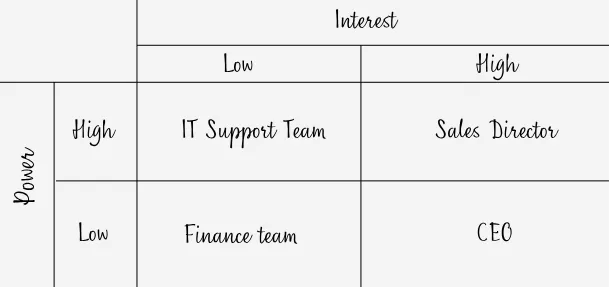The stakeholder power grid helps project managers figure out which stakeholders need the most attention. This visual tool maps out stakeholders based on their power and interest levels, making it easier to tailor your communication strategy and keep projects on track.
Key Topics
- The Power Grid is a 2×2 matrix that plots stakeholders by their level of power and interest in your project
- Four distinct quadrants require different management approaches: Manage Closely, Keep Satisfied, Keep Informed, and Monitor
- Using this tool early in project planning helps prevent conflicts and ensures you’re spending time on the right relationships
A Simple Tool for Stakeholder Analysis
Not all stakeholders are created equal. Some can shut down your project in its tracks — others just want to be kept in the loop. That’s where the stakeholder power interest grid comes in handy.
When you’re managing a project, you’ll quickly find out that stakeholder management can make or break your success. The challenge isn’t just identifying who your stakeholders are — it’s figuring out how much time and energy to invest in each relationship. Some stakeholders need constant updates and involvement in every decision. Others prefer to stay in the background unless something goes wrong.
The Power Grid gives you a clear framework for sorting this out. By the end of this article, you’ll know how to use this tool to streamline your stakeholder communication and keep everyone happy without burning yourself out.
What is a Power Grid?

The Power Grid, also known as the Power/Interest Grid or stakeholder mapping matrix, is a project management tool that helps you visualize and categorize your stakeholders. It’s rooted in stakeholder theory and has been around for decades, helping project managers tackle complex stakeholder landscapes.
The grid works with two simple axes.
- The vertical axis represents Power — how much influence a stakeholder has over your project’s success or failure.
- The horizontal axis shows Interest — how much they care about the project’s outcome.
When you plot stakeholders on this grid, you end up with four distinct quadrants. Each quadrant tells you exactly how to approach that group of stakeholders. It’s like having a roadmap for your stakeholder relationships, showing you where to focus your energy and where you can ease up a bit.
The Four Quadrants Explained

Let’s break down each quadrant and what it means for your stakeholder management approach:
High Power, High Interest – Manage Closely
These are your key players — the stakeholders who can make or break your project and genuinely care about the outcome.
Think of your project sponsor, key customers, or department heads who depend on your deliverables. You need to keep these folks closely involved in decision-making processes. Set up regular check-ins, invite them to important meetings, and make sure they’re on board with major changes before you move forward.
High Power, Low Interest – Keep Satisfied
This group has the authority to shut things down, but they’re not particularly invested in the day-to-day details. Maybe it’s a senior executive who signed off on the budget but doesn’t want to be bothered with weekly updates.
Your goal here is to keep them satisfied without overwhelming them with information. Send them high-level summaries, flag any major issues early, and make sure they know you’ve got things under control.
Low Power, High Interest – Keep Informed
These stakeholders really care about your project but don’t have much say in how it runs. They might be end users, team members from other departments, or subject matter experts (SME).
Since they’re genuinely interested, they can become your biggest advocates if you keep them in the loop. Share regular updates, ask for their input when appropriate, but don’t let them derail your timeline with endless discussions.
Low Power, Low Interest – Monitor with Minimal Effort
This final group doesn’t have much influence over your project and isn’t particularly concerned with the outcome. Don’t ignore them completely — situations can change, and today’s low-priority stakeholder might become tomorrow’s key decision-maker. But you don’t need to spend much time here. Keep them on your stakeholder list and send occasional updates, but focus your energy elsewhere.
Why Use the Power Grid?
The stakeholder power grid gives you several practical benefits that can save you time and headaches down the road.
First, it helps you tailor your communication strategy. Instead of sending the same generic updates to everyone, you can customize your approach based on what each group actually needs. High-power, low-interest stakeholders get executive summaries. High-interest groups get detailed progress reports.
Second, it helps you avoid nasty surprises. When you map out who has power over your project early on, you’re less likely to get blind sided by someone you didn’t realize could block your progress. You’ll also spot potential conflicts before they blow up.
The Power Grid works best when you use it during the initiation or planning phase of your project. That’s when you have time to think through your stakeholder landscape and set up the right communication rhythms from the start.
Quick Example

Let’s walk through a realistic example. Imagine you’re managing a software implementation project for your company’s new CRM system.
Your CEO (High Power, Low Interest) approved the budget but doesn’t want to hear about technical details. You’ll send her monthly high-level status reports and flag any major budget or timeline issues.
The Sales Director (High Power, High Interest) will be heavily impacted by the new system and has strong opinions about features. You’ll involve her in key decisions, schedule weekly check-ins, and make sure she’s comfortable with the rollout plan.
Your IT Support team (Low Power, High Interest) will need to support the system once it’s live. They’re eager to understand how it works, but can’t influence major decisions. You’ll include them in training sessions and send them detailed technical documentation.
The Finance team (Low Power, Low Interest) will use the system occasionally for reporting, but aren’t particularly concerned about the implementation. You’ll add them to your monthly newsletter but won’t spend much time on one-on-one communication.
Tips for Using the Grid Effectively
Keep your Power Grid updated as your project moves forward. Stakeholder power and interest levels can shift based on changing business priorities or organizational restructuring.
The Power Grid works even better when you combine it with other stakeholder management tools like stakeholder registers or RACI charts. Think of it as part of your overall stakeholder management toolkit, not a standalone solution.
Don’t write off those low-power, high-interest stakeholders. They might not be able to approve your budget, but they can become your strongest advocates when things get tough. Keep them engaged, and they’ll help you build support throughout the organization.
Conclusion
The stakeholder power interest grid takes the guesswork out of stakeholder management. Instead of treating everyone the same way, you can focus your time and energy where it matters most.
Start mapping your stakeholders early, keep the grid updated, and watch how much smoother your project relationships become.
Give it a try on your next project — you’ll wonder how you managed stakeholders without it.

